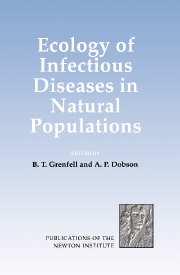Book contents
- Frontmatter
- Contents
- List of Participants
- Introduction
- BROAD PATTERNS AND PROCESSES
- PATHOGENS, INSECTS AND PLANTS
- Nonlinearities in the Dynamics of Indirectly-Transmitted Infections (or, does having a Vector make a Difference?)
- Model Frameworks for Plant-Pathogen Interactions
- The Dynamics of Insect-Pathogen Interactions
- IMPACT OF ECOLOGICAL AND GENETIC HETEROGENEITY
- Glossary
The Dynamics of Insect-Pathogen Interactions
Published online by Cambridge University Press: 22 January 2010
- Frontmatter
- Contents
- List of Participants
- Introduction
- BROAD PATTERNS AND PROCESSES
- PATHOGENS, INSECTS AND PLANTS
- Nonlinearities in the Dynamics of Indirectly-Transmitted Infections (or, does having a Vector make a Difference?)
- Model Frameworks for Plant-Pathogen Interactions
- The Dynamics of Insect-Pathogen Interactions
- IMPACT OF ECOLOGICAL AND GENETIC HETEROGENEITY
- Glossary
Summary
Introduction
Insects are abundant members of all terrestrial and freshwater ecosystems and are also of immense economic importance, largely as pests and disease vectors, but occasionally having a more positive influence on human well-being as in the case of silk moths and honey bees. That they are subject to a variety of diseases has been understood for several centuries, but it has only been with the development of modern microbiology in the last sixty or so years that the widespread occurrence and biological diversity of insect diseases has been appreciated. Much of the impetus for the study of insect diseases has come from the possibility that they might be used as biological control agents to combat noxious pests, or from the need to preserve the health of economically valuable species. Thus the potential for insect diseases to control or regulate their host populations has been understood for many years. However, the ecological study of the population dynamics of insect-pathogen interactions is a relatively new field of biology and most work in this area has been carried out in the last fifteen years.
The aim of this chapter is twofold: first, briefly to review the theory of insect-pathogen population dynamics and to try and identify areas that require further study; and second, to examine the most important case studies of insect-pathogen population dynamics and to discuss whether the predictions from theory are concordant with field experiments and observations. There are two broad theoretical approaches to the study of insect-pathogen dynamics. The first begins with simple strategic and normally analytical models that are then elaborated when particular systems are studied.
- Type
- Chapter
- Information
- Ecology of Infectious Diseases in Natural Populations , pp. 295 - 326Publisher: Cambridge University PressPrint publication year: 1995
- 13
- Cited by



